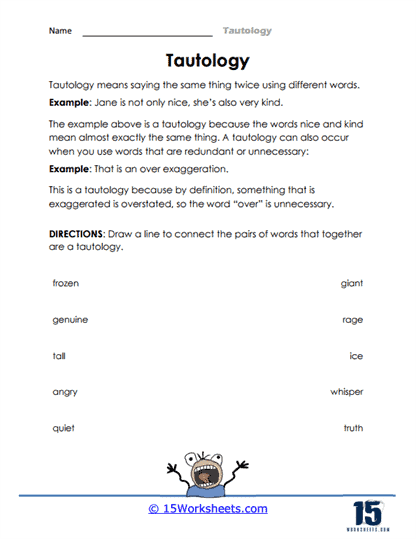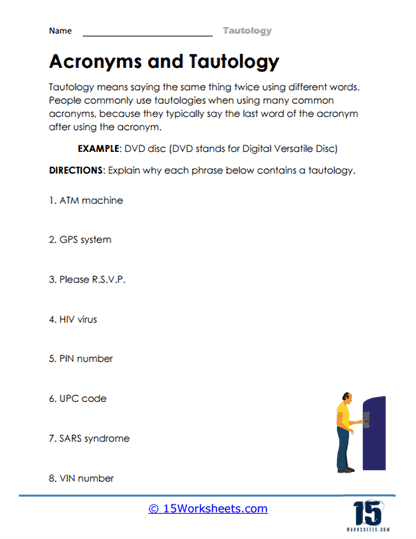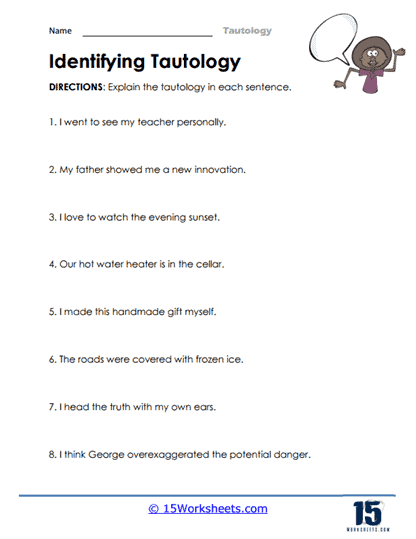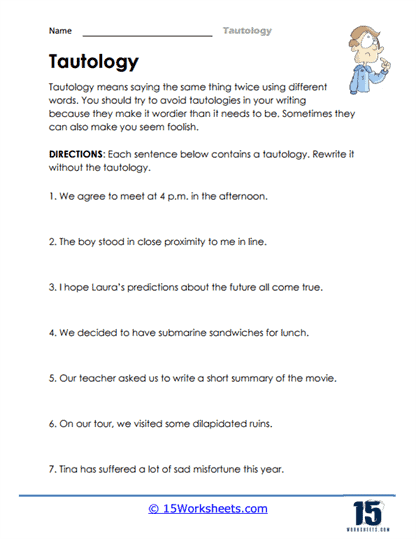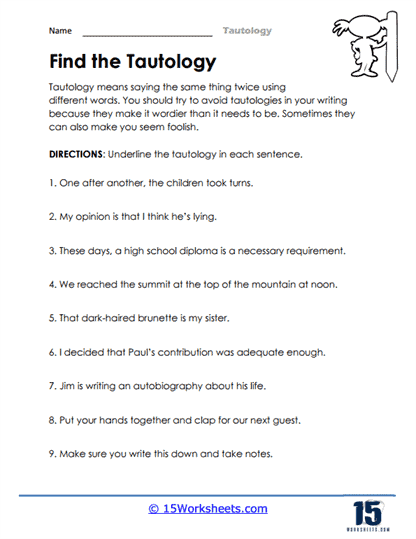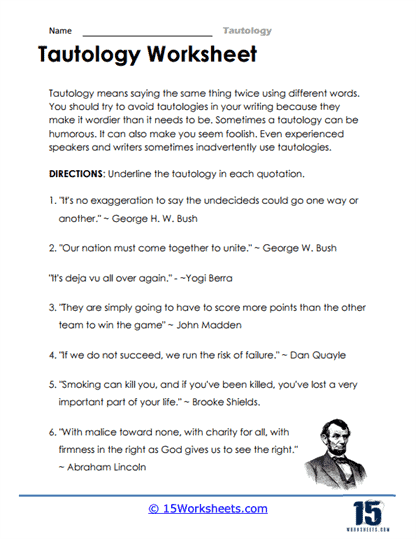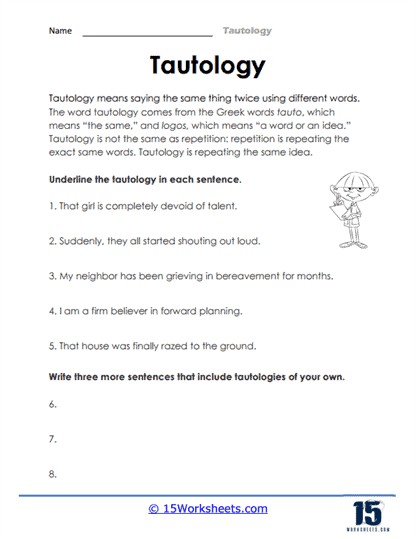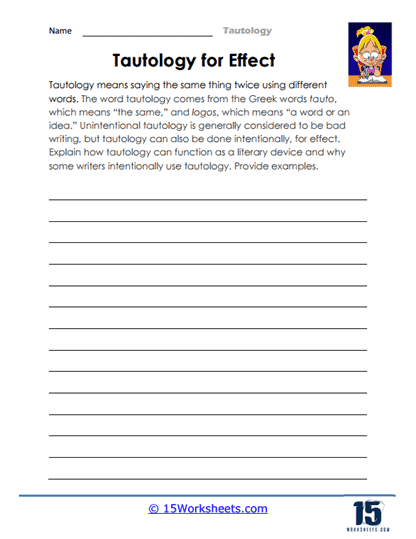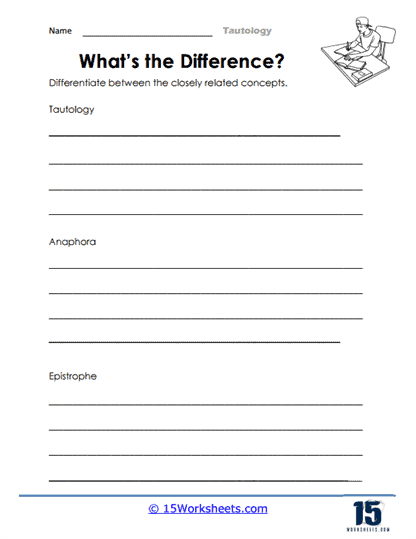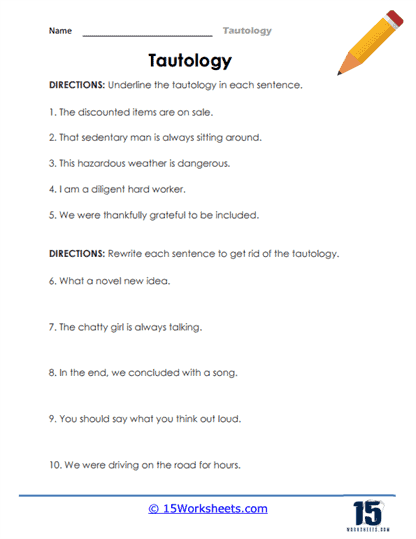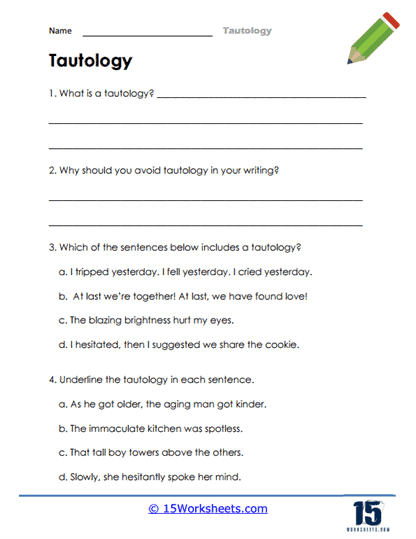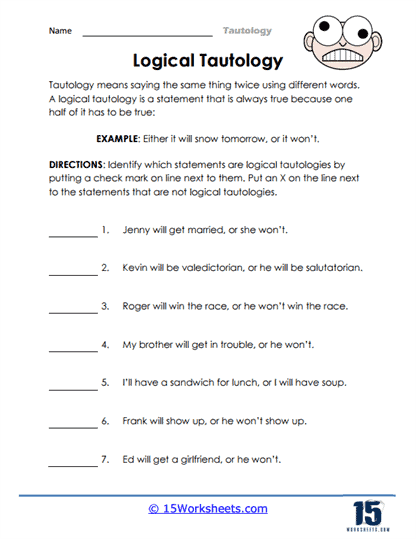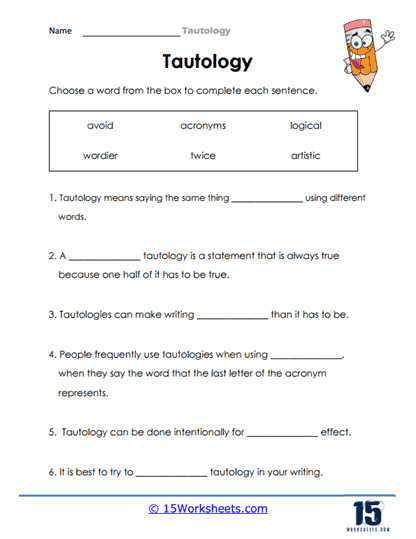Tautology Worksheets
About These 15 Worksheets
These worksheets work to enhance students’ understanding and use of language by focusing on the concept of tautology in both written and spoken forms. A tautology is a statement or phrase that repeats the same idea in different words, essentially saying the same thing twice in a way that is unnecessary for conveying the message. These redundancies can dilute the clarity and impact of communication, making it crucial for students to recognize and avoid them in their writing and speech. By working with tautology worksheets, students can improve their language arts and reading skills, learn to communicate more effectively, and develop a more sophisticated understanding of language nuances.
Types of Exercises
Identification – These exercises present students with sentences or short paragraphs containing tautological statements. Students are tasked with identifying the redundant phrases, helping them recognize unnecessary repetition in language.
Correction – After identifying tautologies, students are then asked to rewrite the sentences or paragraphs, removing the redundancy while retaining the original meaning. This practice encourages concise and clear expression.
Comparison – Students compare pairs or sets of sentences where one sentence contains a tautology and the other conveys the same idea more succinctly. This highlights the impact of tautology on the effectiveness of communication.
Creative Writing – Assignments prompt students to write short stories, essays, or descriptions, explicitly instructing them to avoid tautological expressions. This fosters creativity and precision in language use.
Comprehension – Some worksheets may include reading passages followed by questions that test students’ understanding of how tautologies were used or avoided in the text, emphasizing the importance of precision in language for clear communication.
Critical Thinking – These exercises challenge students to justify why certain phrases may or may not be considered tautological in different contexts, encouraging deeper engagement with language nuances and context sensitivity.
Discussion Prompts – Worksheets may provide prompts for group discussions about the effect of tautologies on communication, the difference between tautology and emphasis, and the role of repetition in literary devices like anaphora, fostering analytical and interpretive skills.
How These Worksheets Help You
Enhanced Clarity and Precision – By identifying and eliminating tautologies, students learn the importance of clarity and precision in communication. This skill is crucial not only in writing but also in verbal communication, where concise and clear language can significantly impact the listener’s understanding and engagement.
Improved Writing Skills – Regular practice with tautology worksheets helps students develop a more refined writing style. By avoiding redundant expressions, their writing becomes more direct and impactful, qualities highly valued in academic and professional contexts.
Vocabulary Expansion – In the process of correcting tautologies, students are often required to find alternative ways to express the same idea. This search encourages them to delve into their vocabulary, leading to discovery and incorporation of new words and phrases.
Critical Reading Skills – Tautology worksheets cultivate students’ ability to critically analyze texts. By learning to identify unnecessary repetition, students can better assess the effectiveness of an author’s language use, contributing to a more nuanced understanding of text analysis.
Increased Awareness of Language Nuances – The exercises on these worksheets make students more aware of the subtleties of language, including how repetition affects meaning and reader perception. This awareness is essential for both interpreting literature and crafting effective arguments.
Strengthened Editing and Revising Skills – Correction exercises specifically bolster students’ editing and revising skills. Through the practice of refining their own and others’ writing to eliminate tautologies, students become more adept at self-editing, a critical skill in the writing process.
Enhanced Analytical and Interpretive Skills – The critical thinking and discussion prompts included in tautology worksheets encourage students to think deeply about language and its functions. This not only improves their analytical skills but also fosters a greater appreciation for the artistry of language.
Better Understanding of Emphasis vs. Redundancy – Through exercises that explore the fine line between using repetition for emphasis and falling into tautology, students learn how to use repetition effectively in their writing without detracting from the message.
Development of Conciseness in Communication – Regular practice with these worksheets teaches students the value of conciseness. They learn that brevity can often lead to stronger, more persuasive communication, a lesson applicable in various academic and real-world scenarios.
Cultivation of Listening Skills – As students become more attuned to spotting tautologies in written language, they also develop a sharper ear for redundant expressions in spoken language. This heightened listening skill can improve their overall communication and comprehension abilities.
What is the Literary Device of Tautology?
Tautology, as a literary device, involves the redundant use of words or phrases that repeat the same idea, effectively saying the same thing twice in different words. Its main defining feature is this repetition of an idea or statement, which on the surface may seem unnecessary or even a flaw in communication. However, when used intentionally in literature, tautology can serve a variety of purposes, including emphasis, clarification, or to impart a particular stylistic quality to the text.
Characteristics of Tautology
Redundancy – The core characteristic of tautology is redundancy. It involves using more words than necessary to express an idea, often repeating the same concept in different words within the same sentence or statement.
Emphasis – Tautology is often used to emphasize a particular point or idea. By repeating the same information in a slightly different way, authors can make sure the reader gives extra attention to it.
Clarification – Sometimes, tautologies are used to clarify complex ideas by presenting them in multiple ways within the same context, thereby making them more accessible to the reader.
Aesthetic Quality – In some cases, tautologies contribute to the rhythmic, poetic, or stylistic qualities of a text. They can create a certain cadence or enhance the overall mood of the writing.
Persuasion – In rhetoric and persuasive writing, tautology can be a tool for reinforcing an argument or point of view, making it seem more undeniable or self-evident.
Examples of Tautology in Literature
“Free Gift”
The phrase “free gift” is a common example of tautology in advertising language, but it is also found in literature, especially in satirical works critiquing consumer culture. Here, the term “gift” inherently implies that it’s free, making the qualifier “free” redundant. This tautology is used to draw the reader’s attention to the absurdity of how products are marketed, highlighting the manipulative language of advertising.
“It was deja vu all over again” – Yogi Berra
While not from a literary work in the traditional sense, this famous quote by Yogi Berra encapsulates the essence of tautology. “Deja vu” already means the feeling of having experienced something before, so adding “all over again” repeats the same idea. This humorous redundancy captures the bewildering and repetitive nature of the experience, emphasizing its intensity and the amusing perplexity it can cause.
Shakespeare’s “But, for my own part, it was Greek to me.” – Julius Caesar
In this example, Shakespeare uses tautology to emphasize a character’s confusion and lack of understanding. While not a direct repetition, the idea that something is “Greek” to someone is a colloquial way of stating that it is incomprehensible. The redundancy lies in the fact that stating it was “for my own part” already implies a personal inability to understand, making the phrase a subtle tautology. This enhances the character’s expression of bewilderment and personal disconnection from the knowledge.
The Effect of Tautology on the Reader
The effect of tautology on the reader can vary depending on its use and context within the text. When used skillfully, it can:
Draw Attention – By repeating an idea in different words, tautology can make certain parts of the text stand out, ensuring that the reader pays closer attention to these segments.
Add Emphasis – Tautology can underline or emphasize a particular point, making it more memorable or impactful.
Enhance Rhythm and Mood – Especially in poetry and prose, the repetitive nature of tautology can contribute to the rhythm of the text, enhancing its aesthetic appeal or emotional impact.
Provoke Thought or Amusement – In some cases, the apparent redundancy of tautology can provoke thought about the nuances of language or amuse the reader with its playful use.
Clarify or Simplify – By restating an idea in different terms, tautology can help clarify complex concepts, making them more accessible to the reader.

